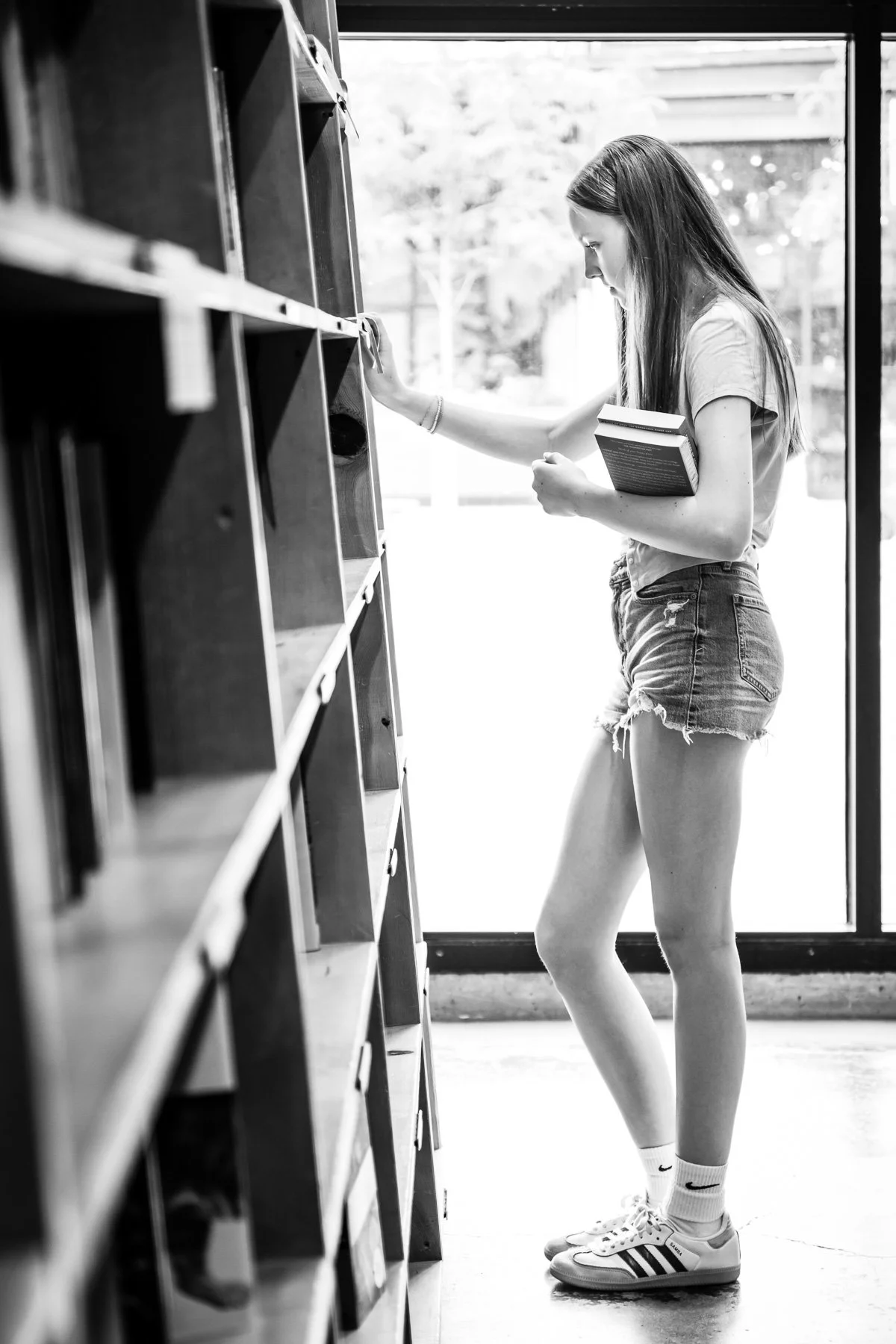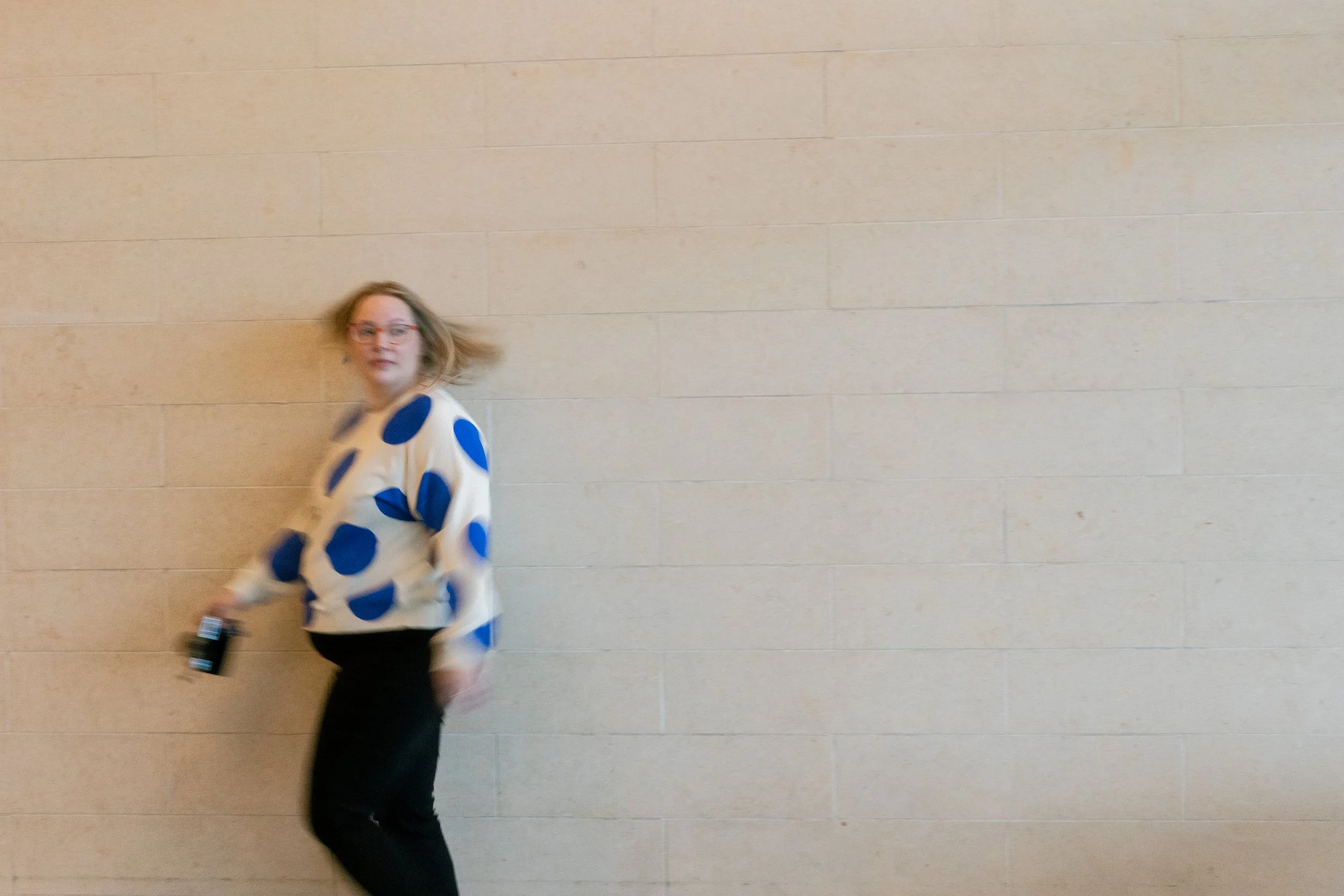Why Your Best Photo Is Rarely Your First Frame
One of the most valuable lessons I’ve learned in photography is this: your first frame is almost never your best photo.
Whether you’re in an iconic location or your own backyard, the real magic often happens when you work the scene…experimenting, refining, and staying with your subject until you’ve created the strongest possible image.
Recently, I had the chance to put this into practice at one of Portland’s most beloved landmarks: Powell’s Books. This wasn’t a perfectly lit studio session or a golden hour outdoor session. It was a real-world environment with challenging light, busy backgrounds, and my teen daughter (who does not exactly jump for joy when I pull out my camera). In other words, the perfect place to lean in on working the scene.
The Challenge: Powells Books Is An Iconic Location…But Imperfect
Powell’s Books is full of visual charm, but it’s not exactly a dream lighting scenario. Think fluorescent lighting mixed with warm tungsten tones and the orange hue of wooden bookshelves. Add in crowds and visual clutter, and you’ve got a recipe for images that can feel chaotic.
In the past, I’d walked away from Powell’s without a photo I truly loved. But this time, I noticed my daughter standing near a large window. The natural light was streaming in behind her creating a perfect backlight to separate her from the busy store. And she was actually willing to let me take a few photos.
This is where working the scene comes in.
The Gear I Used
I took these images with my Fuji XT-5 and Sigma 18–55mm f/2.8 lens. This is my go-to travel and everyday kit. It’s lightweight, discreet, flexible, and still capable in low light.
What It Means to “Work the Scene”
Working the scene means pushing past the first frame that feels “good enough” and exploring every possible way to make a stronger image.
That might mean:
Moving your feet: forward, back, higher, lower
Using elements in the environment for framing
Changing your angle or lens choice
Adjusting your subject’s position to catch better light or simplify the background
Keeping your camera up just a little longer, because the magic often happens in those in-between moments
It’s not about overshooting…it’s about working with intention.
How I Worked the Scene at Powell’s Books
Find the Light First
I placed my daughter so the strongest light was behind her, framing her silhouette and keeping her face gently lit from the side.
Change My Perspective
I crouched low, stepped back, and used bookshelves in the foreground to frame her and hide distractions.
Experiment with Movement
I had her shift her body slightly, look different directions, tried slowing the shutter speed to blur any outdoor people or cars, and even adjust her height so I could play with the composition and light falloff.
Refine Without Rushing
I kept going until the combination of lines, light, and her expression felt right. The first frame wasn’t it. But after a few different combinations I loved what we’d created together.
Select with Intention
When I reviewed my images in Lightroom later, I wasn’t looking for “every good photo.” I was looking for the photo — the one where every element worked together.
Breakdown of my images from Powells Books
Here’s the un-edited ‘proof sheet’ of all the images I took in this location. I use a specific method of organizing my Lightroom catalog with culling…so my initial pass included ‘flagging’ the images I was interested to look at further, as well as two to delete. One thing to note, is you can really see how I was trying slightly different exposures, compositions, framing, and leading lines.
These are the images that I was interested in taking a closer look at after quickly culling the images…with my final selections to edit marked with the blue star.
Here are the straight out of camera (SOOC), color edit, and black and white (BW) edits of my three final selections. I’d like to walk you through part of why I selected each image, and the thoughts I had while editing each photo.
Image 1: Standing on step stool
I was curious if I could change how she was framed and adding the stepstool could be ironic for our family because my daughter is already quite tall… it didn’t quite work out as I had hoped, but I liked how her face was easier to see with the black behind it. But, to me this image was too busy even after straightening it in photoshop, and the outside was also distracting. So, it wasn’t my favorite.
Image 2: Framed while standing straight
I decided that having the two shelves coming together as converging lines wasn’t going to work with the window framing, so I decided to just lean into one side of the shelves leading lines, and framing from the backlit window…but her body position was a bit more stiff and reserved feeling which lead me to the final image.
Image 3: Framed while reaching the shelf with leg bent
Image 3 was my favorite final edit from this short little session at the book store. I like how she’s touching the bookshelf, adding further connection, and her bent knee makes her appear more relaxed. I like the color combo of the books she’s holding in the color version, but am also quite drawn to the nostalgia felt with the black and white edit. In post I brought the exposure up on my daughter, straightened all of my lines, and then cropped to enhance the diagonal lines and the frame of the window.
Here are the final edited images where you can look at them more closely:
Takeaways for Photographers
Look for the light
Even in challenging environments, interesting light changes everything.
Move, move, move
Your best composition might be one step to the left, or just a few inches below your eye level.
Always be on the lookout for compositional elements
Shelves, doorways, and architecture can direct the viewer’s eye to your subject creating a stronger image.
Don’t stop shooting too soon
Push past “good enough” until you’ve explored the scene fully.
Powell’s reminded me that strong images aren’t about perfect conditions, they’re about persistence and refinement. The next time you’re out with your camera (or even documenting your story at home), give yourself permission to slow down, explore, and work your way from “good” to “great.”
Want more composition tips? Download my free guide, Conscious Composition & Color Framework here.
Check out more photography education posts on the blog…




















![Behind The Frame, part vi [holiday edition]](https://images.squarespace-cdn.com/content/v1/63fa85e6b613c058ef6dad60/1697649643699-NNLCW5SRG1G3898W594V/how-the-holiday-photo-was-made-00002.jpg)


![Behind The Frame, part iv [Self Portrait Edition]](https://images.squarespace-cdn.com/content/v1/63fa85e6b613c058ef6dad60/f1c6ff0b-a00e-4ba4-8692-bfcac136ac8e/Rebecca-Hunnicutt-Photography-Self-Portraits-4.jpg)













